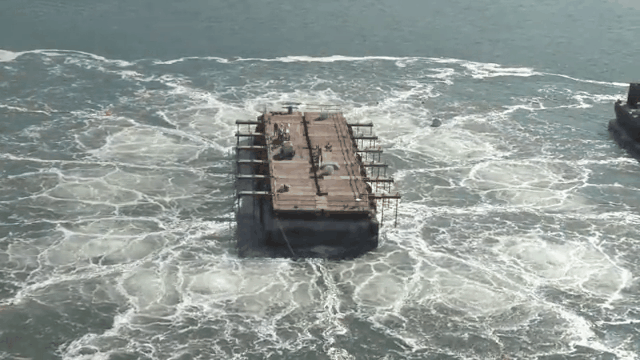One of the largest remaining chunks of San Francisco’s Bay Bridge is coming down tomorrow, as engineers continue to dismantle the ageing piece of infrastructure. But how to protect the fish and other wildlife in the area as it gets taken down? By blowing bubbles.
The implosion of the large pier, named E3, has been delayed for months due to environmental concerns. After scientists were worried about the many birds which live in the old spans and piers, a November date was finally decided upon because it would be the least disruptive when it came to migration and mating. The blast will happen at slack tide so fewer creatures will be in the water. But there are a few other tech tricks in place to keep animals far away from the explosion.
Animation from Caltrans showing the debris cage on top, location of charges and bubble curtain
The engineers opted to use hundreds of small controlled charges embedded within the pier to mitigate the impact. The pier itself, which is about as tall as a five-story building, has been outfitted with a wood and steel cage that will trap flying debris. Then, before the 9072kg of dynamite are detonated, a fleet of barges outfitted with air compressors will create a “bubble curtain” that will help disperse the impact of the underwater shockwave. The whole thing will only take six seconds.
In a video of the test blasts you can see how the bubble curtain swarms around the pier
Sadly, even the bubble curtain will not be able to stop the shockwave entirely, which is still expected to kill 1,775 endangered longfin smelt (an oddly specific number). But engineers claim that this is the better solution: The environmental impact from slowly dismantling the pier by hand during many months and potentially years would only drag out the process and kill more animals over time.
In addition to the bubble curtain, scientists will be out on boats in the bay to help scare away other birds and mammals from the blast site. However, if certain species are spotted to close to the area, it could delay the event:
Scientists will be on the lookout in particular for two diving birds, the endangered least tern and the protected brown pelican. If either is diving within 500 feet of the pier, the implosion could be put off while monitors use laser pointers and air horns to try to shoo it away. Caltrans hopes harbour seals and sea lions will be deterred by a ring of noise-emitting buoys.
Providing no brown pelicans want a spa bath, you’ll be able to watch the implosion live around 1:45am AEDT (6:45am PT) today at Caltrans’ YouTube channel.
